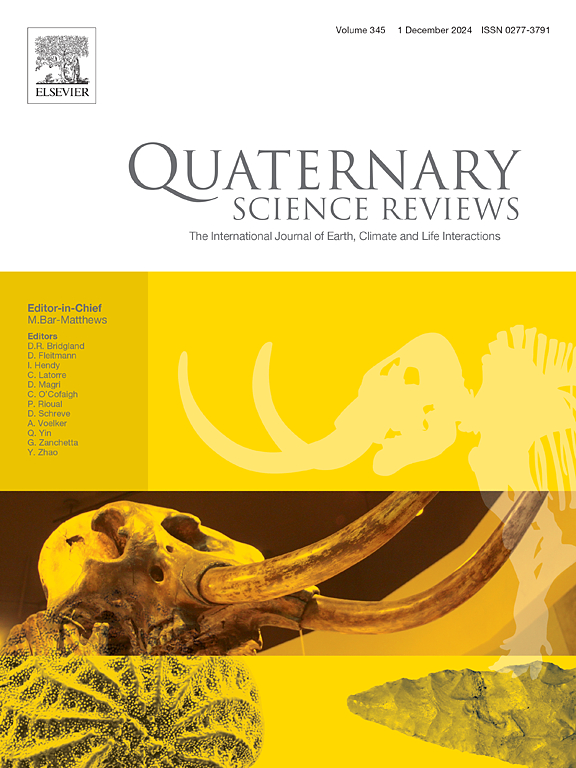Can we use springtails to improve our understanding of Antarctic Ice Sheet history? — A case study from Dronning Maud Land
IF 3.2
1区 地球科学
Q1 GEOGRAPHY, PHYSICAL
引用次数: 0
Abstract
The presence of unique biological archives (e.g., springtails, Arthropoda: Collembola) in Antarctic ice-free regions provides powerful evidence for testing assumptions about when and how the current ice sheet reached its present-day configuration. Springtails, where present, may suggest long-term (thousands to millions of years) ice-free conditions. Springtails might also provide crucial evidence of ice-free conditions in locations (often inland) where cosmogenic nuclide data are complicated by the influence of cold-based ice. We use published geological dating evidence from Dronning Maud Land (DML), East Antarctica, a region where numerous ice-free mountains (nunataks) currently protrude through the East Antarctic Ice Sheet, to test the utility of Antarctic springtails for understanding the evolution of ice-free terrain. We first categorise and plot all published cosmogenic nuclide data (ages, isotope concentrations) across DML using a series of distinct criteria to determine if they show 1) strong evidence for long-lived ice-free terrain, 2) moderate evidence for long-lived ice-free terrain, or 3) a complex burial-exposure history. Second, we compare the distribution of Antarctic springtails (requiring ice-free habitat to survive in situ) against this geological evidence, guided by their molecular data, where available. Our results imply that springtail populations coincide with areas adjacent to high (+2000 m a.s.l.) nunataks that have remained ice-free over timescales of thousands and in some cases millions of years, a finding that is supported by molecular information in the Sør Rondane Mountains, DML. Given the heterogeneous (and short-range endemic) presence of many springtails, they offer scope to improve knowledge of ice sheet changes more widely in Antarctica.

我们能利用弹跳尾巴来提高我们对南极冰盖历史的了解吗?——以Dronning Maud Land为例
南极无冰地区存在独特的生物档案(如鞘氨醇,节肢动物门:鞘翅目),这为检验有关当前冰盖何时以及如何达到目前构造的假设提供了有力证据。存在的春尾虫可能表明长期(数千年到数百万年)的无冰条件。在宇宙成因核素数据因冷基冰层的影响而变得复杂的地方(通常是内陆),春亚尾也可能为无冰条件提供重要证据。我们利用南极洲东部德龙宁毛德地(Dronning Maud Land,DML)(该地区目前有许多无冰山脉(nunataks)突出于南极洲东部冰盖)已发表的地质年代证据,来检验南极春尾对了解无冰地形演变的作用。首先,我们使用一系列不同的标准对整个 DML 地区所有已公布的宇宙成因核素数据(年龄、同位素浓度)进行分类和绘图,以确定它们是否显示:1)长寿命无冰地形的有力证据;2)长寿命无冰地形的中等证据;或 3)复杂的埋藏-暴露历史。其次,我们将南极春尾虫(需要无冰栖息地才能在原地生存)的分布与这些地质证据进行比较,并以其分子数据(如有)为指导。我们的研究结果表明,南极箭尾种群与高海拔(海拔+2000米)nunataks附近的地区相吻合,这些地区在数千年甚至数百万年的时间尺度内一直保持无冰状态。鉴于许多鞘氨醇的异质性(和短程特有性)存在,它们为更广泛地增进对南极洲冰盖变化的了解提供了空间。
本文章由计算机程序翻译,如有差异,请以英文原文为准。
求助全文
约1分钟内获得全文
求助全文
来源期刊

Quaternary Science Reviews
地学-地球科学综合
CiteScore
7.50
自引率
15.00%
发文量
388
审稿时长
3 months
期刊介绍:
Quaternary Science Reviews caters for all aspects of Quaternary science, and includes, for example, geology, geomorphology, geography, archaeology, soil science, palaeobotany, palaeontology, palaeoclimatology and the full range of applicable dating methods. The dividing line between what constitutes the review paper and one which contains new original data is not easy to establish, so QSR also publishes papers with new data especially if these perform a review function. All the Quaternary sciences are changing rapidly and subject to re-evaluation as the pace of discovery quickens; thus the diverse but comprehensive role of Quaternary Science Reviews keeps readers abreast of the wider issues relating to new developments in the field.
 求助内容:
求助内容: 应助结果提醒方式:
应助结果提醒方式:


